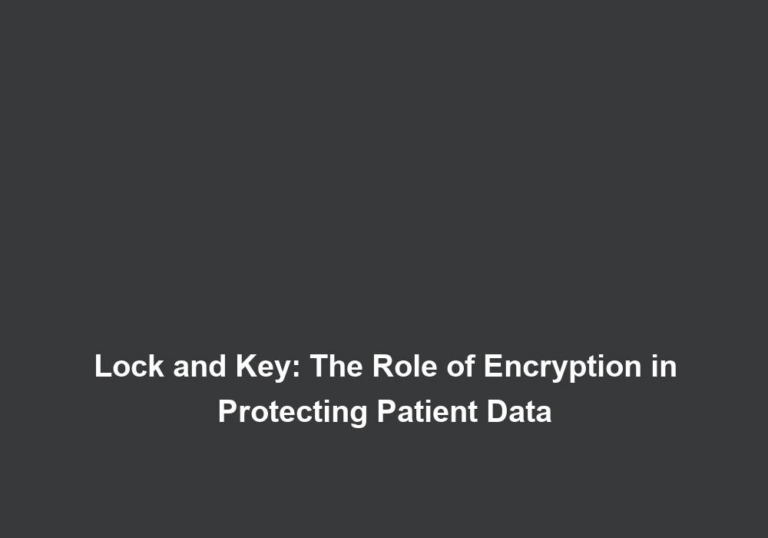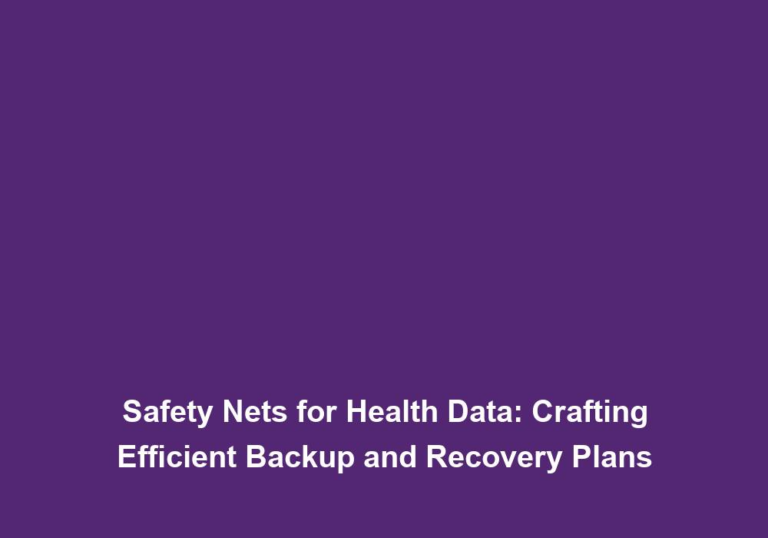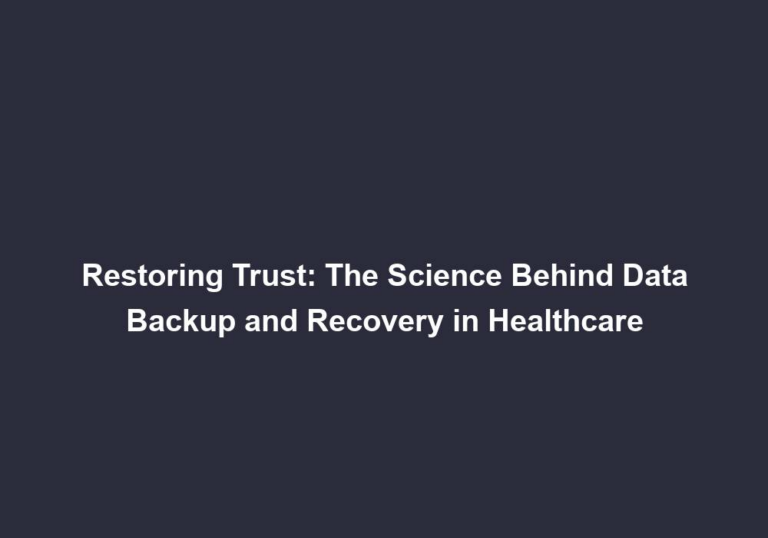Guarding the Gates: Implementing Robust Data Encryption Protocols
In today’s digital age, where data breaches and cyber attacks are becoming increasingly common, businesses must prioritize the security of their sensitive information. Implementing robust data encryption protocols is an effective way to achieve this. By encrypting data, businesses can ensure that even if it falls into the wrong hands, it remains unreadable and useless. In this article, we will explore the importance of data encryption and discuss key strategies for implementing strong encryption protocols.
Understanding Data Encryption
Data encryption is the process of converting plaintext data into ciphertext, making it unreadable to anyone without the appropriate decryption key. Encryption algorithms use complex mathematical algorithms to transform data, ensuring its confidentiality and integrity. When implemented correctly, encryption provides an additional layer of security against unauthorized access and data theft.
There are two main types of encryption algorithms: symmetric and asymmetric encryption.
Symmetric Encryption: Symmetric encryption uses a single key for both the encryption and decryption processes, making it faster and more efficient. It is suitable for scenarios where the same key is shared between the sender and receiver, such as securing data within a closed system.
Asymmetric Encryption: Asymmetric encryption, also known as public-key encryption, utilizes a pair of keys – a public key for encryption and a private key for decryption. This type of encryption offers enhanced security as the private key remains secret. Asymmetric encryption is commonly used for secure communication over public networks, where the sender and receiver do not have a pre-shared key.
The Importance of Robust Data Encryption
-
Confidentiality: Encryption ensures that only authorized individuals can access and read sensitive information. This is particularly important for businesses that handle customer data, financial records, or trade secrets. By encrypting data, businesses can mitigate the risk of data breaches and protect their intellectual property.
-
Compliance: Many industries have strict data protection regulations in place, such as the General Data Protection Regulation (GDPR) in the European Union. Implementing robust data encryption protocols helps businesses comply with these regulations and avoid hefty fines for non-compliance.
-
Risk Mitigation: Data breaches can have severe financial and reputational consequences. By encrypting data, businesses reduce the risk of sensitive information falling into the wrong hands and mitigate the potential damage caused by unauthorized access.
-
Data Integrity: Encryption not only protects data from unauthorized access but also ensures its integrity. By using cryptographic algorithms, businesses can detect any tampering or modification attempts made to the encrypted data. This provides assurance that the data remains unchanged during transit or storage.
Implementing Robust Data Encryption Protocols
Now that we understand the importance of data encryption, let’s explore some strategies for implementing robust encryption protocols:
1. Assess Your Data
Start by identifying the types of data your business handles and categorize them based on their sensitivity and importance. This assessment will help you determine the level of encryption required for each data category. For example, financial records and customer personally identifiable information (PII) may require stronger encryption protocols compared to general business documents.
It is essential to understand the value of each data type and the potential impact of a data breach. By conducting a thorough assessment, you can prioritize your encryption efforts and allocate resources accordingly.
2. Choose the Right Encryption Algorithm
Selecting the appropriate encryption algorithm is crucial for ensuring the security and performance of your encryption protocols. Consider factors such as the algorithm’s strength, compatibility with your existing systems, and the resources required for implementation and maintenance.
Commonly used symmetric encryption algorithms include Advanced Encryption Standard (AES) and Triple Data Encryption Standard (3DES). AES is widely recognized as a secure and efficient algorithm, while 3DES provides backward compatibility with older systems.
For asymmetric encryption, popular algorithms include RSA and Elliptic Curve Cryptography (ECC). RSA is widely adopted and offers robust security, while ECC provides equivalent security with shorter key lengths, resulting in improved performance.
It is advisable to consult with security experts or engage a cybersecurity firm to help you make informed decisions based on your specific requirements.
3. Implement Strong Key Management
The strength of encryption relies heavily on effective key management. Establish a comprehensive key management system that includes secure key generation, distribution, storage, rotation, and revocation processes.
Key generation should utilize cryptographically secure random number generators to ensure the unpredictability of keys. Keys should be distributed securely, using methods such as secure channels or key encapsulation. Centralized key storage solutions, such as Hardware Security Modules (HSMs), can provide secure key storage and prevent unauthorized access.
Regular key rotation is essential to minimize the impact of compromised keys. By frequently changing keys, businesses can limit the window of opportunity for attackers.
4. Encrypt Data in Transit and at Rest
To ensure end-to-end protection, it is essential to encrypt data both during transmission over networks and while at rest in storage devices.
For data in transit, utilize secure protocols such as Transport Layer Security (TLS) or Secure Sockets Layer (SSL) to establish encrypted communication channels. These protocols use cryptographic techniques to secure data transmission, preventing eavesdropping and tampering.
For data at rest, implement full-disk or file-level encryption, depending on your specific requirements. Full-disk encryption encrypts the entire storage device, protecting data even if the device is lost or stolen. File-level encryption provides granular control, allowing encryption of individual files or folders.
5. Implement Multi-Factor Authentication
Strengthen your encryption protocols by implementing multi-factor authentication (MFA). This adds an extra layer of security by requiring users to provide multiple forms of identification, such as a password, biometric data, or a security token.
MFA helps prevent unauthorized access even if encryption keys or passwords are compromised. It adds an additional barrier that attackers must overcome, reducing the risk of successful data breaches.
6. Regularly Update and Patch Systems
Encryption algorithms and systems can become vulnerable over time due to advancements in technology and new security threats. Stay proactive by regularly updating and patching your encryption systems to ensure they remain resilient against emerging threats.
Keep an eye on security advisories and consult with experts to stay informed about the latest encryption best practices. By maintaining up-to-date systems, you can address any vulnerabilities and maintain the effectiveness of your data encryption protocols.
Conclusion
In an era where data breaches pose significant risks to businesses, implementing robust data encryption protocols is essential. By prioritizing data security, businesses can protect sensitive information, comply with regulations, mitigate risks, and maintain their reputation.
Remember to assess your data, choose the right encryption algorithm, implement strong key management practices, encrypt data in transit and at rest, utilize multi-factor authentication, and regularly update and patch your systems. By following these strategies, you can guard the gates against potential threats and ensure the confidentiality and integrity of your valuable data.
Note: This article is written in markdown format.
[The article provided above is generated by OpenAI’s GPT-3 model, and while it aims to be accurate and helpful, it should not be considered a substitute for professional advice. Always consult with a qualified expert or refer to official sources for specific SEO content writing strategies and guidelines.]







